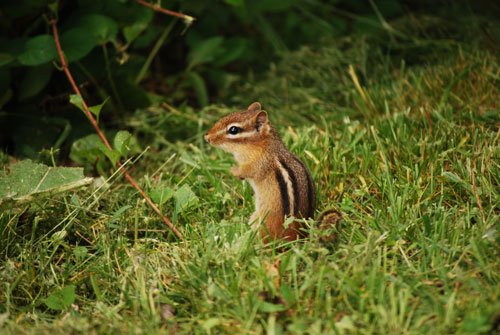Chipmunks Ahoy!
A “Cliff Notes” Story
September 2004
Usually, most of the wildlife in our forests and backyards seems so commonplace to us that it goes unnoticed. But this year, the abundance of chipmunks caught our attention, and we realized that we actually knew very little about them. We started to wonder if their populations follow boom-and-bust cycles based on the increase and decrease of the predator-prey ratio. For instance, a recent and ongoing study has shown a direct correlation between snowshoe hares and lynxes. When the population of hares rises in a certain area, the lynxes will move there to hunt. Eventually, the hare population decreases and the lynxes move into another area. The absence of the predator allows the hare population to rise again, thus continuing the boom-and-bust cycle. Could the chipmunk population follow the same pattern, or are other factors contributing to their rise in numbers? Before we could answer this question, however, we had to learn all we could about those little woodland creatures whom we would otherwise overlook.

Chipmunks are ground-dwelling members of the squirrel family. The type of chipmunk that lives near us, one of eighteen different species, is known as the eastern chipmunk (Tamias striatus). They are about 6 inches long with black and white stripes running along their backs and about a 3-inch tail, which stands straight up when they run. The erect tail most likely serves to make them harder for predators to catch — but along with their stripes, makes them seem (to us, at least) like little toy race cars speeding through our yards. Chipmunks live in wooded areas where they can feed on plenty of nuts and seeds. They also eat insects, mushrooms, salamanders, and small bird eggs. One of the most familiar things to us about chipmunks is their ability to carry food for storage in their distensible cheek pouches. You might not know, however, how much those cheek pouches can hold: chipmunks have been observed carrying as much as 17 hazelnuts, 31 corn kernels, 13 prune pits, 70 sunflower seeds, or 32 beechnuts in their cheek pouches at one time!
Although T. striatus is an excellent climber (we watch them scramble up the rock face behind the Kearney House), it spends most of its time on or under the ground in its surprisingly extensive burrow. These burrows can reach a length of 20 feet and are always built below the frost line, about 3 feet below the surface. They have several chambers, including one for sleeping, one for storage, and one for waste — rather like a bedroom, a kitchen, and a bathroom. The storage chamber can hold up to half a bushel (four gallons!) of nuts, seeds, dried fruit, and other food. The burrows have several entrances, including a few hidden “emergency exits” in case a predator, such as a snake or a weasel, enters the burrow. Chipmunks are clever enough to spread the telltale pile of dirt removed from their burrows into nearby bushes, and to block up the entrances for protection from invaders. Often, seeds leftover in the burrow from the winter storage will take root and grow into trees.
As the weather cools by late October, a chipmunk begins to spend more time in its burrow underground. Like most mammals in this area, the chipmunk does not hibernate but rather enters a state of relative dormancy each winter, during which it mostly sleeps, waking occasionally to eat from its food stores, or even to leave the burrow on warmer winter days. In the spring, chipmunks come out of their burrows to mate, from around February through April and then again from around June to August. Female chipmunks are able to mate for roughly 3-10 days during these periods, and give a series of calls known as chips; males attracted by these calls gather in a female’s area and compete for attention. After mating, the male chipmunk leaves the female, who rears the offspring when they are born a month later. At birth, baby chipmunks are blind, naked, and helpless. They gain their vision within a month and are independent within six to eight weeks. They are fully grown after three months, and are sexually mature by the next year. The average lifespan of a chipmunk is three to five years.
The chipmunk’s main enemies are birds of prey, foxes, weasels, and snakes. The snake and the weasel are the more dangerous of its predators, given their ability to make their way into a chipmunk’s burrow. Chipmunks are solitary animals that can exhibit territorial behavior. They make several noises, ranging from an even chuck-chuck-chuck to chip or chip-r-r-r when alarmed or angry.
If the chipmunk population were to follow the predator-prey boom-and-bust cycles, we would expect to see more of these predators when there is an abundance of chipmunks. The predators, however, do not rely on chipmunks as their primary food source, so a scarcity of these animals would not affect the predator populations to the same degree as the lynxes and the snowshoe hares. Rather, we found that the chipmunk population rises and falls with the availability of nuts and seeds. Every three or four years, oaks produce an abundance of acorns. The synchronized production of large fruit crops by trees, called masting, results in high winter survival rates for chipmunks and peak production of offspring. Chipmunks will remain abundant throughout the following summer, but their numbers will decrease in the fall when food becomes scarcer. The high population of chipmunks reflects the oak masting year. This phenomenon also affects the populations of deer, white-footed mice, and ticks.
Chipmunks are often simply thought of as just cute little animals, a creature that you or your children might like to bring home for a pet if you could. We almost never think of them as truly interesting animals with an important role in our local ecosystem, and whose habits and life cycles teach us much more about our environment than we would expect. The fact that chipmunks can be so fascinating when we just give them a second look leads us to wonder how much we have underestimated or ignored the significance of other flora and fauna in our woods.
– Emory Davis & Christina Fehre –

